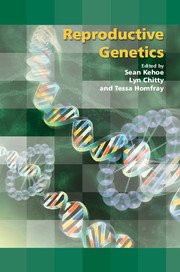Book contents
- Frontmatter
- Contents
- Participants
- Declarations of personal interest
- Preface
- 1 Genetic aetiology of infertility
- 2 Disorders of sex development
- 3 Preimplantation genetic diagnosis: current practice and future possibilities
- 4 Ethical aspects of saviour siblings: procreative reasons and the treatment of children
- 5 Epigenetics, assisted reproductive technologies and growth restriction
- 6 Fetal stem cell therapy
- 7 Prenatal gene therapy
- 8 Ethical aspects of stem cell therapy and gene therapy
- 9 Fetal dysmorphology: the role of the geneticist in the fetal medicine unit in targeting diagnostic tests
- 10 Fetal karyotyping: what should we be offering and how?
- 11 Non-invasive prenatal diagnosis: the future of prenatal genetic diagnosis?
- 12 Non-invasive prenatal diagnosis for fetal blood group status
- 13 Selective termination of pregnancy and preimplantation genetic diagnosis: some ethical issues in the interpretation of the legal criteria
- 14 Implementation and auditing of new genetics and tests: translating genetic tests into practice in the NHS
- 15 New advances in prenatal genetic testing: the parent perspective
- 16 Informed consent: what should we be doing?
- 17 Consensus views arising from the 57th Study Group: Reproductive Genetics
- Index
2 - Disorders of sex development
Published online by Cambridge University Press: 05 February 2014
- Frontmatter
- Contents
- Participants
- Declarations of personal interest
- Preface
- 1 Genetic aetiology of infertility
- 2 Disorders of sex development
- 3 Preimplantation genetic diagnosis: current practice and future possibilities
- 4 Ethical aspects of saviour siblings: procreative reasons and the treatment of children
- 5 Epigenetics, assisted reproductive technologies and growth restriction
- 6 Fetal stem cell therapy
- 7 Prenatal gene therapy
- 8 Ethical aspects of stem cell therapy and gene therapy
- 9 Fetal dysmorphology: the role of the geneticist in the fetal medicine unit in targeting diagnostic tests
- 10 Fetal karyotyping: what should we be offering and how?
- 11 Non-invasive prenatal diagnosis: the future of prenatal genetic diagnosis?
- 12 Non-invasive prenatal diagnosis for fetal blood group status
- 13 Selective termination of pregnancy and preimplantation genetic diagnosis: some ethical issues in the interpretation of the legal criteria
- 14 Implementation and auditing of new genetics and tests: translating genetic tests into practice in the NHS
- 15 New advances in prenatal genetic testing: the parent perspective
- 16 Informed consent: what should we be doing?
- 17 Consensus views arising from the 57th Study Group: Reproductive Genetics
- Index
Summary
Introduction
Disorders of sex development (DSD) are defined as ‘congenital conditions in which development of chromosomal, gonadal or anatomical sex is atypical’. DSD therefore represent a diverse range of conditions that can present at different ages and to a range of different healthcare professionals. Typically, a baby born with ambiguous genitalia will be referred to a paediatric endocrinologist or urologist but DSD can also present in adolescence to gynaecologists because of primary amenorrhoea in a girl, or even in adulthood to fertility services because of difficulty having children. Furthermore, an increasing number of individuals with DSD are being diagnosed in fetal medicine units following a discordance between prenatal karyotyping (performed for another reason) and genital appearance on ultrasound or at birth. An awareness of this range of conditions is thus important for practitioners in many different fields.
Given the diverse and complex nature of DSD, a multidisciplinary team (MDT) approach involving various healthcare professionals with experience and interest in this area is essential (for example, endocrinologist, urologist, gynaecologist, psychologist, geneticist, cytogeneticist, biochemist and ethicist). While this team need not necessarily be involved in every case of apparently ‘simple’ hypospadias if managed by an experienced urologist, an MDT approach is necessary for more complex cases of DSD where there are diagnostic, management and sex assignment issues.
Our knowledge of the causes of DSD, especially at the molecular level, has increased significantly in the past 20 years.
Keywords
- Type
- Chapter
- Information
- Reproductive Genetics , pp. 15 - 34Publisher: Cambridge University PressPrint publication year: 2009
- 1
- Cited by



